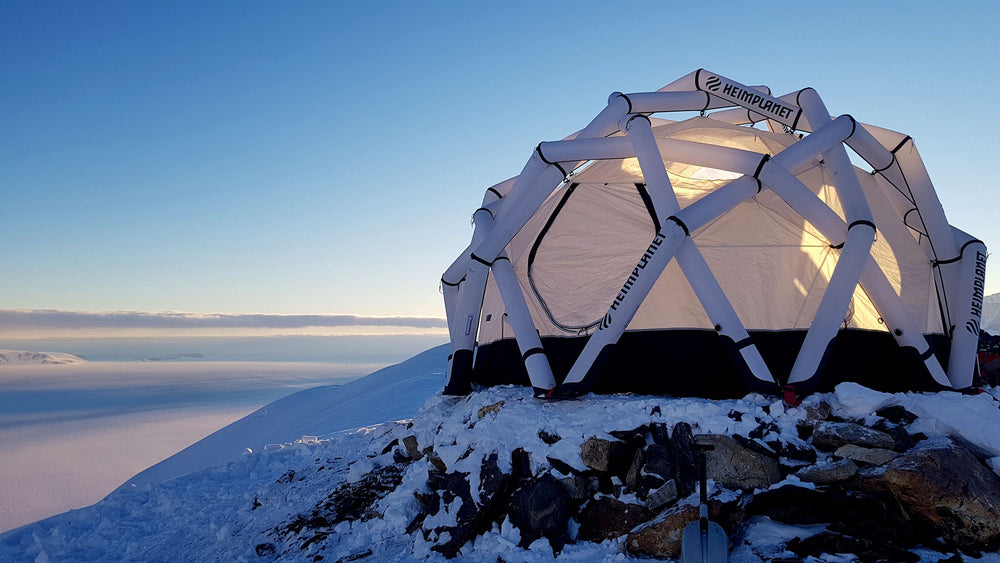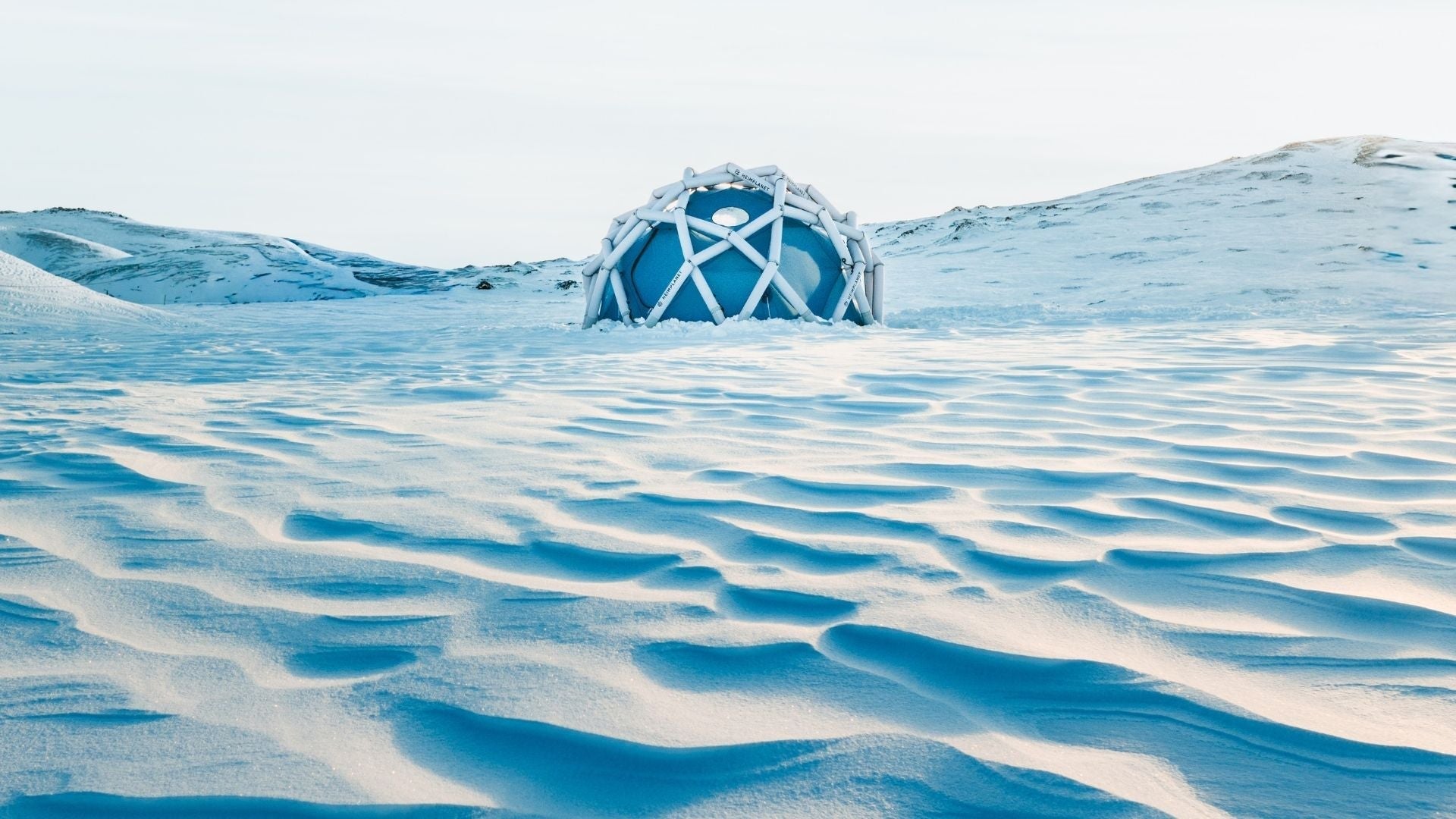HEIMPLANET IN DER ANTARKTIS
HEIMPLANET hat kürzlich mit neuseeländischen Wissenschaftlern zusammengearbeitet, um deren Forschung zum Klimawandel in der Antarktis zu unterstützen. Aber wie schützt man empfindliche wissenschaftliche Instrumente in der rauesten Umgebung der Welt? Mit dem stärksten Zelt der Welt - dem Mavericks!

Mit heulenden Winden und Temperaturen von unter -30 °C ist das südliche Ende unserer Erde weit von Laborbedingungen entfernt. "Besonders wenn man messen will, wie das Eis mit dem Ozean interagiert, stößt man schnell an die Grenzen des Machbaren", sagt Christian Wild, Eisforscher an der Universität von Canterbury. Er ist gerade von einer Expedition zum Priestley-Gletscher zurückgekehrt, einem großen Gletscher, der den antarktischen Eisschild durch die transantarktische Gebirgskette in den Ozean entwässert.

Um ein umfassendes Verständnis der Prozesse in der Nähe der Grundlinie zu erlangen, wo der Gletscher in direkten Kontakt mit dem Ozean kommt, ist es wichtig, den Beitrag der Antarktis zum aktuellen Meeresspiegelanstieg abzuschätzen. Die "Kiwi-Forscher" installierten ein hochempfindliches Radargerät auf einem exponierten Bergrücken, um zu erfassen, wie die Gezeiten des Ozeans den Fluss des Gletschers beeinflussen. Das Problem bei diesem Radargerät ist, dass es nicht durch Metallstangen hindurchsehen kann, wie sie in den üblichen Polarzelten zu finden sind. Aber eine Form des Schutzes vor den antarktischen Elementen ist absolut notwendig, um ein Wackeln des Geräts im Wind zu vermeiden.

Das einzigartige Design des Mavericks war die perfekte Lösung. Mit Hilfe des HEIMPLANET-Teams wurde das Zelt für seinen "eiskalten" Einsatz modifiziert. Alle Metallteile wurden gegen speziell angefertigte Kunststoffteile ausgetauscht, um mögliche Störungen des Radars zu vermeiden. Klammern wurden durch Schnüre ersetzt, die Verankerung des Zeltes wurde so weit wie möglich verstärkt und Führungsseile wurden zu Ankerleinen. Außerdem mussten die Wissenschaftler ein Loch in den Boden schneiden, um Platz für das Stativ des Radars zu schaffen - alles im Namen der Wissenschaft. "In der Antarktis gibt es keinen Overkill, es gibt nur eine angemessene Vorbereitung".
Oben auf dem Kamm entdeckte Christians Team, dass die Antennen des Radars zu lang waren, um genügend Abstand zum Zelt zu haben.
"Wir mussten das Zelt auf einer Steinmauer aufstellen, um genügend Platz zu haben, falls der Wind zunehmen würde. Um ihre Steinmauer zu errichten, mussten die Wissenschaftler jedoch zuerst die Gipfelsteine loswerden - eine anstrengende Aufgabe, vor allem, wenn man nur ein Paket hat.

Nachdem sie zwei Tage lang mit bloßen Händen Steine gesammelt und aufgeschichtet hatten, waren die Wissenschaftler bereit, mit der Messkampagne zu beginnen. "Wenigstens hatten wir jeden Tag viel Sonnenlicht. Unterhalb des antarktischen Kreises (66,6° S) kann die Sonne in den australischen Sommermonaten 24 Stunden lang über dem Horizont stehen. Das Radar tastete dann die Oberfläche des Priestley-Gletschers alle drei Minuten kontinuierlich über einen ganzen Frühjahrs-Nap-Gezeitenzyklus ab."

Unsere Aufzeichnungen sind hervorragend, da wir nun untersuchen können, ob sich der Gletscher in verschiedenen Phasen der Flut beschleunigt oder ob er gleichmäßig ins Meer fließt. Diese kurzfristige Beschleunigung des Gletscherflusses wird häufig bei der Interpretation von Satellitenbildern übersehen, die dieses Gebiet nur alle paar Tage überwachen. Während der Messkampagne brauchte das Radar nicht viel Aufmerksamkeit - aber die Wissenschaftler mussten das Instrument dennoch täglich warten. Wir verbrachten jeden Tag mindestens eine Stunde im Zelt, tippten mit Wollhandschuhen und warteten verzweifelt darauf, dass das Herunterladen der Daten abgeschlossen war.

Wie kalt war es?
Manchmal konnte ich nur durch die Nase atmen, um die kalte Luft zu erwärmen, bevor sie meine Lunge erreicht - das ließ meine Nasenlöcher gefrieren."
Wie gelingt es warm zu bleiben?
Wir tragen mehrere Schichten Daunenjacken und Merinowäsche. Keine Baumwolle, da sie den Körper schnell auskühlt, wenn sie nass wird.
Gibt es noch andere Tipps oder Tricks?
Wir haben uns eine Tanzchoreographie ausgedacht, um taube Gliedmaßen aufzuwärmen.

Nach zwei Wochen auf dem Bergrücken war der Datensatz vollständig und die Wissenschaftler wurden aus dem Feld abgezogen. Unsere koreanischen Mitarbeiter kamen mit vier Hubschraubern, die in Formation über das Eis flogen - beeindruckend!
Was geschah danach?
Wir flogen zum Stützpunkt namens Jang Bogo zurück, mit unserer gesamten Ausrüstung, wissenschaftlichen Geräten, Müll und menschlichen Abfällen. Wir haben nur Fußspuren im Schnee hinterlassen und Fotos gemacht. Zurück in der Basis stellte der koreanische Stationsleiter das Unterfangen der Wissenschaftler auf eine Stufe mit Amundsens Expedition zum Südpol vor über 100 Jahren - eine Ehre. Wir wurden mit gegrilltem Schweinebauch, Samgyeopsal, einer Delikatesse der koreanischen Küche, willkommen geheißen, so viel man essen kann. Vor allem der Koch der Basis versorgte sie in den nächsten Tagen mit Fleisch, bis die Kiwi-Entdecker mit der Royal Air Force nach Neuseeland zurückkehrten. Der Blick auf das Transantarktische Gebirge war atemberaubend - eine riesige, lebensfeindliche Umgebung, aber auch unberührt und schützenswert vor menschlichen Eingriffen.
Wie fühlt es sich an, dort zu sein?
Es ist, als wäre man auf einem anderen Planeten. Die Extreme-Cold-Weather-Gear ist dein Raumanzug und die Basis deine Kommandozentrale. Wir betrachteten uns als Eis-Tronauten. Dies war der erste erfolgreiche Einsatz eines Radarsystems in der Antarktis. Die Mavericks leisteten hervorragende Arbeit, um das Instrument vor den heulenden Winden der Antarktis zu schützen.
Irgendwelche Vorschläge für Verbesserungen?
Ja, wir brauchen es noch größer, damit wir beim nächsten Mal keine Mauer bauen müssen. Das hat zwar Spaß gemacht, aber mit unseren steifen Fingern konnten wir morgens keine Tasse Tee halten.








